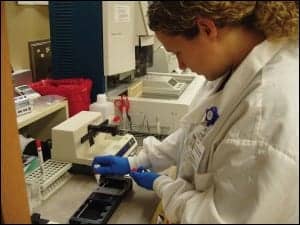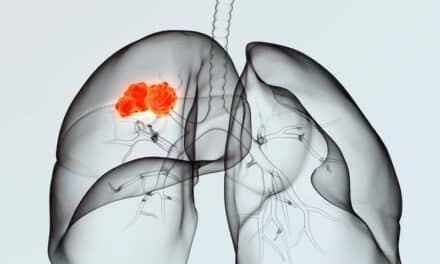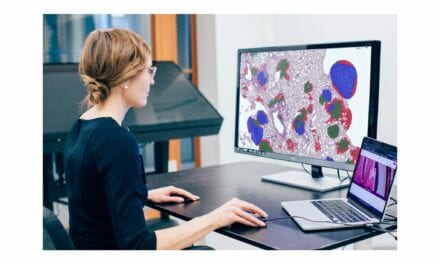Weighing fast turnaround versus accuracy in a large health system can occasionally be tricky. Clinicians expect fast results, but they also want them to be accurate and objective. When the CentraCare Health Plaza lab, located in St Cloud, Minn, set its sights on improving its vaginitis testing method, however, the choice was a no-brainer.
The CentraCare Health System features seven labs and is one of the largest health service organizations operating in central Minnesota. The medium-sized Health Plaza lab serves primary and specialty clinics, including one for women’s health.
Two years ago, the lab was using traditional wet prep microscopy methods to test for the three distinct pathogens—Trichomonas, Candida (yeast), and Gardnerella—which cause 90% of all vaginitis cases. While wet prep testing can allow experienced lab techs to turn around a sample in as little as 15 minutes, the highly specialized, labor-intensive method offers only moderate sensitivity and specificity. To perform a vaginitis test using the wet prep microscopy method, techs would first prepare a sample slide with saline and acid and then place it under a scope for a manual identification, followed by a pH test and a whiff test to help identify Gardnerella.
Although still the clinical standard, sensitivity for the microscopy method hovers between 50% and 60%, and results are subjective, often varying significantly from one tech to another. Accurate detection can also be complicated by outside factors. Trichomonas, for example, is typically easier to spot than its bacterial cousins Gardnerella and Candida, but the pathogen is identified by movement, which makes timely detection a necessity. "You could have had Trichomonas, but if there was a delay in getting the sample and the Trichomonas died, we would have missed it," says Deb Reber, a clinical laboratory scientist at the Health Plaza lab. "We could only call it positive if we saw the organism."
The whole process took only about 15 minutes to complete—with a 30-minute turnaround. But what time the lab could save using the manual method was lost to a cumbersome reporting process, which required techs to report out nine parameters one at a time on a keypad.

The BD Affirm VPIII helps identify the three distinct pathogens that cause 90% of all vaginitis cases.
Getting the Green Light
While at a conference, senior lab staff discovered the BD Affirm VPIII system, from BD, Franklin Lakes, NJ, a new vaginitis testing system based on DNA probe technology that can offer improved sensitivity, specificity, and detection rates for all three leading vaginitis pathogens.
"When looking at DNA testing in general—we really are looking at that sensitivity/specificity," says Cindy Johnson, director of laboratory operations for CentraCare, who has served more than a decade at the health system. Johnson worked closely with clinicians to gauge their feedback on switching testing methods, and recalls that their primary concern was a potential increase in time to results.
"We have a highly efficient laboratory, so clinicians are used to getting results very quickly," she says. "We did get push-back that this new method would increase turnaround time, but when you get more sensitive and specific, you’re not falsely treating a patient, so the doctors saw the benefit of that."
The lab eventually secured approval, but selling CentraCare’s more than 50 clinicians did take some work. Senior lab staff spent months meeting with clinicians and responding to their concerns. "They asked tough questions," Johnson says. "It was hard, but I think they needed to ask them. One of the physicians said, ‘I would rather call my patient with an accurate result than give them a result that’s marginal and have them come back for treatment,’ and everyone else said, ‘You’re absolutely right.’ "
Smoothing the Transition
Even after a long haul with CentraCare’s discerning clinicians, the lab still had to cool its heels before it could introduce the system full time. In June 2008, the lab brought the instrument in-house to perform a parallel study alongside its traditional methods. The results were promising, and 1 year later, the lab was using two Affirm instruments to replace the wet prep method.
To get acclimated, the lab hosted a representative from BD who walked each tech through the new procedure. To run a test on the Affirm system, techs add a lysis solution to a sample slide and let it incubate for 10 minutes. Then they add a buffering solution, put the sample into a 7-division cassette, and add a card containing complimentary DNA to Trichomonas, Gardnerella, and Candida. Techs return after a 30-minute walkaway period while the sample runs on the analyzer and check for color development.
From start to finish the whole process can take between 40 and 50 minutes, but the lab can shave off additional time if volume is high. "We try to batch samples," Reber says. "But we’ve got a 75-minute turnaround time, so if only one comes in and the 10-minute incubation is up, we’ll just run it."
To report out samples, the lab manually reads results from the analyzer and enters them into the LIS, a process Laboratory Coordinator Cathy Bengtson prefers over reporting out parameters one by one. "Before, we had nine parameters to report out. You had to do it on a keypad, and there were just a lot of strokes for each one," she says. "Now, we basically just enter positive or negative on the keyboard when the result pops up. I think we’ve probably decreased our errors in reporting because of that."
Additionally, the Affirm system provides the lab another important benefit: the ability to report combined infections. "With the manual method, we would report out either Gardnerella or yeast based on what we saw and on the pH," Bengtson says. "We did not—as I recall—ever report out a combined infection. One would preclude the other."
Improvement Affirmed
To confirm that sensitivity and specificity really had improved, the lab put its testing with the Affirm under the microscope in a small study that compared positive identifications on more than 600 samples from both before and after the system’s implementation. After the introduction of the Affirm system, positive rates increased for Gardnerella by 12.2% and Candida by 4.5%. For Trichomonas the increase was less noticeable, at 0.1%.
"I think that’s just because of the occurrence of that particular pathogen," Johnson explains. "From the days I used to do this under the scope, Trichomonas is very easy to find. If it’s there, it’s there. Sometimes, Gardnerella and Candida aren’t as easy to find."
The lab currently performs about 375 vaginitis tests per month, a number that has grown on average by about 50 tests each month since implementing the Affirm. Long term, CentraCare will standardize testing throughout its lab sites and will be implementing the system in its largest hospital lab in an effort to increase accuracy and decrease the subjective results inherent in manual testing methods like wet prep microscopy.
"Our whole goal in general is to move toward more molecular DNA-based testing," Johnson says. "There was quite a bit of variability using the manual method between laboratory staff. This system has practically eliminated any bias."
Stephen Noonoo is associate editor of CLP.





